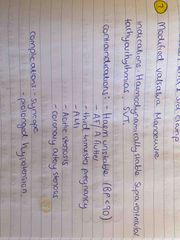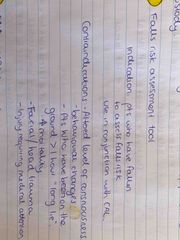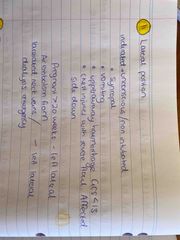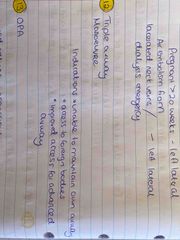![]()
![]()
![]()
Use LEFT and RIGHT arrow keys to navigate between flashcards;
Use UP and DOWN arrow keys to flip the card;
H to show hint;
A reads text to speech;
25 Cards in this Set
- Front
- Back
|
Anatomical splinting. Indications and contraindications. Important notes 📝 |
Back (Definition) |
|
|
Donway splint. Indications and contraindications. |
Back (Definition) |
|
|
Cervical collar, indications and contraindications |
Back (Definition) |
|
|
Pressure bandage (nite management) indications and contraindications |
Back (Definition) |
|
|
Tpod pelvic binder. Indications and contraindications |
Back (Definition) |
|
|
Non vigorous newborn |
Cut the cord when pulsation ceases. X3. 10cm, 15cm and 20cm. Cut between 2nd and 3rd clamp. |
|
|
Modified valsalva. What are the indications and contraindications? What are the complications? |

Back (Definition) |
|
|
Application of virca |
Voluntary Informed of risks/ consequences Relevant refusal. Relates to treatment Capacity. Understands consequences Advice. If valid refusal then advice given. Patient has to satisfy all criteria. Ask the patient to repeat info back. We do not assess capacity in mental health patients. We assess them against the criteria of protective custody. |
|
|
Falls risk assessment tool. Indication and contraindications |

Back (Definition) |
|
|
Lateral position |

Back (Definition) |
|
|
Triple airway manoeuvre |

Back (Definition) |
|
|
OPA |
Indications: unconscious, no gag reflex to maintain patency. Bite block in advanced airway Sizing: from centre of mouth to angle of jaw or corner of mouth to earlobe. Precautions: soft tissue trauma, exacerbate airway obstruction and doesn’t protect against regurgitation/ aspiration |
|
|
NPA |
Back (Definition) |
|
|
Back blows |
Back (Definition) |
|
|
Laryngoscopy |
Back (Definition) |
|
|
BVM and newborn |
Back (Definition) |
|
|
Igel |
Indications: cardiac arrest, unconscious pt without gag reflex, ineffective oxygenation with BVM or basics, unable or difficult intubation and assisted ventilation >10 mins. Select appropriate size Note: doesn’t fully protect the airway from aspiration but there may be less gastric distension with igel than IPPV alone. Forms a seal around the posterior perimeter of the larynx and when correctly seated is superior to the oesophageal sphincter enabling positive pressure ventilation. Contras: intact gag reflex, resistance to insertion, strong jaw tone / trismus, suspected epiglottitis or upper airway obstruction. Precautions: inability to prepare or in sniffing position, pts who require high airway pressures (morbid obese, pregnancy, severe asthma), significant volume of vomit in the airway. |
|
|
Capnography. What is normal and what do the waveforms represent? |
Normal waveform: present when the patient is adequately ventilated. Is spontaneously breathing Has normal CO2 Normal metabolic function |
|
|
Capnography : curare cleft |
Appears when attempts at spontaneous ventilation occurs. Muscle relaxant effect begins to subside |
|
|
Increasing waveform. |
Etco2 > 45 mmhg Decreased RR, decreased TV and increased CO2 through increased metabolic rate and temp |
|
|
Decreasing capnography waveform |
Etco2 <35 mmhg Increased RR, increased TV, decreased CO2 through decreased metabolic rate or body temp. |
|
|
Non baseline waveform |
Back (Definition) |
|
|
Poor inspiratory waveform |
Perhaps airleak or the artificial airway is too small. |
|
|
Poor expiratory waveform |
Partial obstruction or kink in the artificial airway Foreign body/ aspiration Obstruction of expiration circuit (bronchospasm) asthma / COPD Think shark fin |
|
|
Absent waveform on capnography |
Back (Definition) |

